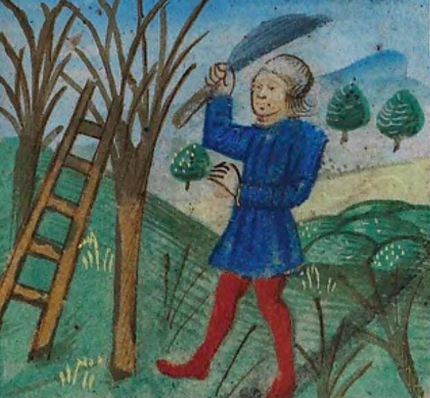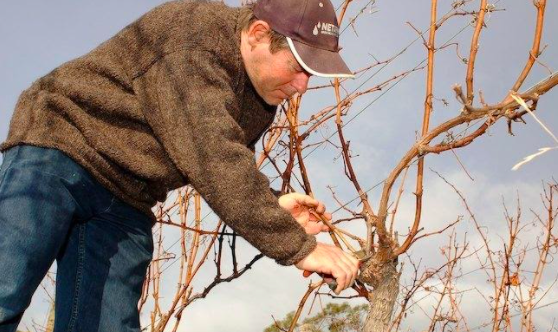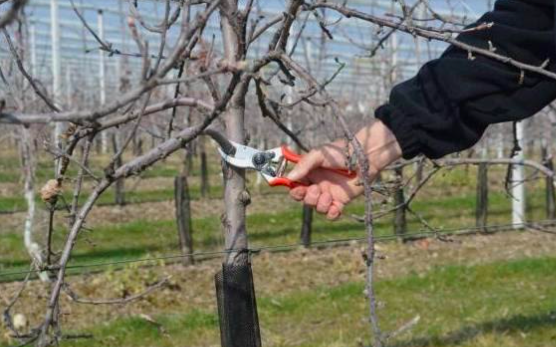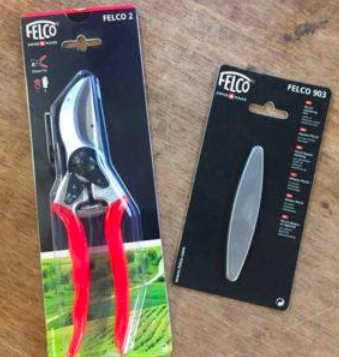
-Pam Scott-
After having had a few months break from rigorous garden chores, you may now feel the call of the outdoors… the need to get this spring thing started. Top on the list of things to do in February is to assess what needs pruning in the garden this year. Late winter is the ideal time to prune a large number of plants in your garden. In our zone 7 climate, most plants are dormant from November to March. There are numerous benefits to pruning plants during this winter dormancy. Plant sap does not run in winter, which helps any pruning cuts to heal more quickly and safely. There are also no fungal spores in the air to get into freshly-pruned plants. With no leaf cover on deciduous plants, you can also easily see the structure of a plant, making it easier to assess where to make your pruning cuts.
Garden plants are pruned to maintain their size, remove any undesirable growth, remove any dead or damaged branches, and to rejuvenate mature plants that have slowed down their fruit or flower production. Fruiting and flowering plants benefit from branch thinning, which helps to spread sunlight and air circulation throughout the plant. This aids in the fight against fungal issues brought about by summer humidity. Trees and shrubs are also pruned to remove crossed branches that may rub against each other.

One of the goals of good pruning is to maintain the natural shape of the plant while encouraging a strong framework for productive growth. There are some plants such as roses, fruiting trees or bushes, as well as grape vines that should be evaluated yearly for pruning needs. Ornamental shrubs, perennials and vines may need pruning based on their flower production and overall health during the growing season. Plants put a lot of energy into stem growth and maintenance. Appropriate pruning can divert this energy into fruit and flower production, invigorating plants to increase the size of their fruits and flowers.
Knowing the appropriate time to prune your garden plants is essential for their health and productivity. Most garden plants will bloom on either new or old branch growth, and sometimes they bloom on both. Knowing which variety of plant you are growing will help you to determine when to prune. As a general rule, plants that bloom on new growth need to be pruned in late winter. Plants that bloom on old growth need to be pruned immediately after flowering. If you don’t know the variety of plant you have, it will help to observe your plant for a year to determine when it blooms and if it blooms on new or old wood.
If you are growing and considering pruning your roses, know that they have very specific pruning needs. Roses that flower only once in a season and bloom on old wood should be pruned right after flowering. Roses that bloom several times during a season, such as Floribundas, hybrid teas, and Grandifloras, bloom on new wood and should be pruned in late February. A rule that will guide you with these varieties is to prune when the Forsythia bloom. In fall don’t cut the last roses off the plant; letting the hips develop will prompt the plant into a strong dormancy which is healthier for the plant. In areas where cane borers are a problem you can use white glue to seal the cuts of woody stem plants such as roses.
Another plant that has varied species pruning requirements that we get a lot of questions about are hydrangeas. Some of the problems gardeners may be having with their Hydrangeas not blooming could be that they are pruning them at the wrong time, possibly cutting off the current year’s flowers. Pruning can improve the vigor of a non blooming hydrangea as well as increase the size of blooms. Old-growth bloomers such as Hydrangea macrophylla, Hydrangea serrata, and the oak leaf Hydrangea quercifolia bloom from spring until mid-summer. These plants can be pruned right after flowering, giving them time to develop next year’s buds. Hydrangeas such as the paniculata and the arborescens varieties bloom from mid summer until fall frost. They can be pruned down to the ground in late winter. Pruning will invigorate old hydrangea plants and increase the size of their blooms.

Clematis is another garden plant that has variety specific pruning needs. Clematis pruning will stimulate blooming, while thinning out will protect the plant from fungal wilt. Clematis that blooms before June have flowers that form on old growth; these can be pruned right after flowering. Clematis that bloom in summer of fall can be pruned strongly in late winter. There are many other ornamental shrubs and vines that bloom on new growth and could benefit from late winter pruning; Beauty Berry, Butterfly Bush, Clethera, Crepe Myrtle, Rose of Sharon and Native Wisteria are just a few. Forsythia, Magnolia, Crabapple and Viburnum should be left alone until after blooming in spring, as they develop flowers on last year’s growth.
The pruning of fruit trees and bushes is very specific to each fruit variety. Fruiting plants should be pruned to promote production, produce good light exposure and air circulation throughout the plant, cut out dead wood that could harbor insects, trim off energy sapping sprouts and suckers and remove any crossed limbs that may rub against other limbs. Reading carefully about each fruit variety that you are planning to prune will help you to make the correct pruning choices. Apples, Cherries, Figs, Pears, Blueberries, Raspberries and grapes will all benefit from a yearly pruning and clean up.

Know that when you make a pruning cut it should be made to a leaf bud that is pointing in the direction you want the branch to grow towards. The cut should be made at 45 degrees, angled away from the bud so water runs away from the bud. Do not make the cut flush to the bud; cut above the branch collar, which is the swollen area below the bud. The branch collar holds a chemical that promotes wood healing. Make sure your pruning is symmetrical and the plant is well balanced. Make your cuts so that bud growth will branch away from the center of the plant opening the plant up to light and air circulation. As you are examining and pruning your plants, clean up any branches and debris under the plants that may harbor pathogens or bugs. Do not dispose of this debris in your compost pile.
Clean your pruning tools between cuts with 2 tablespoons of alcohol mixed with 1 cup water to prevent the spread of pathogens. Use bypass pruners on soft branches of shrubs, perennials and roses. This will make a clean cut that does not crush the stem of the plant, which could interfere with wound healing. Check out Fifth Season’s extensive selection of Bond, Dramm, Barebones or Felco bypass pruners. For thicker stem pruning you will need to use anvil pruners, lopping shears or the Felco Folding Hand Saw. For high up tree branches you may need to use a pole saw along with a good bit of caution. Don’t hesitate to get professional help if the job seems too big for your arsenal of tools.

At Fifth Season Gardening we look forward to providing you with fabulous plants for your garden this spring as well as the tools to fulfill all of your gardening needs!

Connie Huber says
Our first year here, in our home. We have several heather plants. They seem to be crowded. Do I thin them out so the flowers are healthy. Our neighbor has some in bloom. Ours look like dead wood throat the plant.
Thank you
Barton says
Thank you for posting this article on pruning. It should be helpful for those who are intimidated by pruning as well as a refresher for more experienced gardeners.
ashley says
Hi Connie, The first thing to know is whether you have summer- or winter-blooming heather. Since this is your first year in your home, you might wait to see what your plants will do as the growing season movies along. As heathers are evergreen plants, however, if yours have no foliage, in addition to having no blooms, they might, indeed, be dead. I would suggest breaking off some of the branches and seeing if the wood inside is still green or if it’s dead wood. Regarding thinning out plants, heathers don’t like to be crowded, so moving plants apart so there is space around them is a good idea. Heathers also require acidic soil, so you might want to check the pH of your soil to see if it is hospitable to these plants, and if not, do some amending to lower the pH. Hope this helps!
Arborist says
Very helpful and detailed article, especially the part about pruning fruit trees. I often see fruit trees where the fruits are being affected by the lack of trimming, and it seems the owner isn’t aware.
Lc Tree Service says
Such informative and helpful article. You did such a thorough job explaining proper trimming. Thanks for taking the time to share with us.